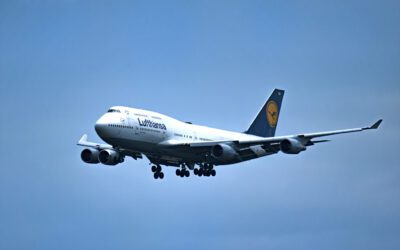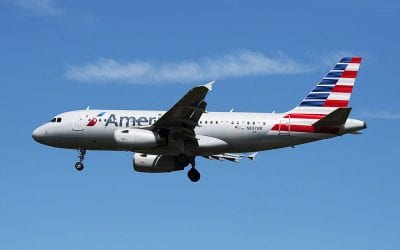Recently, Christopher Muther, a travel columnist for the Boston Globe, proposed to speed up airplane boarding by banning carry-on luggage. He said there are two basic choices to speed boarding; more overhead bin space, or banning carry-on luggage.
Muther’s proposal is the same as part of the Poppi airline concept by the design firm, Teague. The Poppi concept is Teague’s vision of the airline of the future.
Devin Lidell, Teague’s principal brand strategist, claims their boarding model, eliminating carry-ons, can reduce boarding time by 71 percent. Lidell points out that no carry-ons means TSA security could move far more swiftly than it does today, with all those roller carry-ons out of the picture. He suggests the banning could allow passengers to arrive at the airport much later than is required now. I think we can agree that both claims, if true, would be a plus.
Teague point outs eliminating carry-ons doesn’t mean eliminating personal items, such as computer bags and jackets. They’d still be allowed in the Poppi cabin.
Speeding up airport security, boarding, and even deplaning sounds like a great idea, doesn’t it? What passenger would say no to those improvements? Certainly not me, though I’m not convinced those improvements could be accomplished as easily as Teague suggests.
I believe banning carry-ons is far more complex than it appears to many. A variety of factors affect carry-ons, their use, and viability of banning their use.
Central to whether or not carry-ons can be eliminated are: airline baggage liability, standards, checked luggage handling quality, flight duration, airline food and drink policy, including accommodation of dietary restrictions and family travel considerations.
• Airline baggage liability — Business and leisure travelers often travel with equipment and belongings that far exceed the total liability airlines accept. More importantly, there are classes of belongings for which airlines accept no liability, including but not limited to: computers, general electronic equipment, fragile items, medicines, cash, photographic equipment, jewelry, and items considered valuable or irreplaceable.
The Poppi plane allows laptops, tablets, and cellphones in planes’ cabins, but other electronic gear such as extensive camera gear brought on trips by many professionals and leisure travelers would have to be checked. There isn’t enough room in small personal items for all the items airlines won’t accept liability. If carry-ons were banned, it would be essential for the airlines to accept liability for all passenger belongings and raise their liability limit to at least $10,000.
Passengers can purchase travel insurance to cover these items, sometimes for replacement cost, but that substantially adds to the cost of travel.
• Checked luggage handling quality — Checked bags are often handled roughly enough by airlines and airports to break virtually any fragile item in the bags. I’ve personally seen luggage dropped 15 feet or more, to the tarmac. Camera equipment and other breakables are unlikely to survive such handling. Even if covered by the airlines, if broken you won’t be able to use that item during your trip.
At more than a few travel destinations, items normally in carry-ons items, lost or broken might not be able to be replaced until the traveler has returned home. That’s certainly happened to me.
• Flight duration — On short flights, it would be generally easy to get along without the items taken in your carry-on. On longer flights that’s unlikely. Between my carry-on and personal item I take: my camera gear, laptop with accessories, medications, toilet articles particular chosen for me including my shaver, medications, many of which I take daily, valuables, breakables, and a complete change of clothes. On long flights, access to medication, laptop and accessories, some toilet articles, and other items is important. For example, I found access to a change of clothes was twice critical after flight attendants spilled beverage on me on 10+ hour flights.
• Airline food and drink policy — In economy, on US domestic flights, even transcontinental flights, food isn’t served and more than a single soda, juice or water is rarely offered. You can purchase it, but that’s expensive and often doesn’t meet passenger dietary restrictions. In first class, while food is served on longer flights, it’s often lousy. With carry-ons eliminated it’s unlikely passengers will have the ability to bring aboard beverages, or their own food, brought from home, or purchased before boarding.
• Family travel considerations — When traveling with children, especially young children the carry-on needs of parents increase almost exponentially. Parents need to bring games, books, toys, children’s personal items, plus food and drink for their youngsters, if they wish to survive the flight alive. There isn’t room for all that in personal bags.
I believe the issues are far more complex than the Poppi concept and Teague suggestions. Without major changes in airline rules, limits of liability, quality of their baggage handling, and the realization that some flexibility is essential banning carry-ons is essential, banning carry-ons won’t help the passengers.
I believe the airlines and aircraft designers are on the right track, improving carry-on storage capacity, but it’s not enough. Far easier than making major policy changes, and adding to long term airline costs by substantial increases airline luggage liability, if the airlines increase carry-on storage capacity and flexibly enforce carry-on size limits and their one carry-on and one personal item restriction, boarding will improve dramatically.
After many years working in corporate America as a chemical engineer, executive and eventually CFO of a multinational manufacturer, Ned founded a tech consulting company and later restarted NSL Photography, his photography business. Before entering the corporate world, Ned worked as a Public Health Engineer for the Philadelphia Department of Public Health. As a well known corporate, travel and wildlife photographer, Ned travels the world writing about travel and photography, as well as running photography workshops, seminars and photowalks. Visit Ned’s Photography Blog and Galleries.



